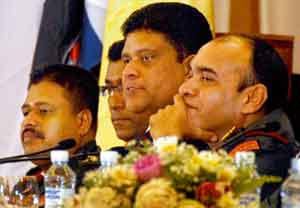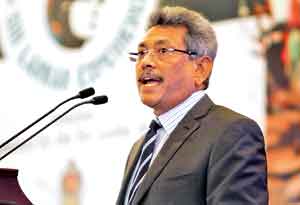Most Sri Lankans and the world outside had a selective version of the decisive last three years of the military campaign in the north and east that ended dramatically with the annihilation of the LTTE leadership in May, 2009.
However, last week, at an open forum of a three day seminar in Colombo, titled, ‘Defeating terrorism –the Sri Lankan experience’, senior field commanders who served in the frontlines spoke on how they fought a formidable and uncompromising enemy, the LTTE. The seminar was attended by more than 300 delegates from over 40 countries.
The seminar, touched on contributions made by members of the Special Forces and other specialized units of the Sri Lanka Army who played a less known but indispensable role in supporting infantry troops to bring to an end a war that had dragged for 30 long years. The crucial role played by the Navy and Air Force in assisting ground troops too was discussed while progress of post-war issues such as resettlement, rehabilitation and re-integration of ex combatants were highlighted.
 |
| Field Commanders who addressed the seminar, from Lto R: Maj. Gen. N. Udawatta, Maj Gen. Shavendra Silva and Maj. Gen Chagi Gallage |
 |
| Gotabaya Rajapaksa delivering the keynote address. Pix by Sanka Vidanagama |
Defence Secretary Gotabaya Rajapaksa who delivered the key note address on the opening day gave a comprehensive picture of how the Government set about overcoming an enemy which by 2005 had, “grown from a small organization of armed individuals to a large, sophisticated terrorist outfit with very advanced combat capabilities.”
By the time the military campaign resumed in 2005, the LTTE had killed more than 26,000 armed services personnel, the Defence Secretary said, adding that at its height the LTTE had more than 30,000 battle-hardened cadres, access to large stockpiles of modern armaments, ammunition and equipment, a sophisticated naval wing and a fledgling air arm.
The Defence Secretary who heaped praise on President Mahinda Rajapaksa for his “clear aim and commitment” to rescue the country from terrorism once and for all, discussing the key factors that led to the success of the humanitarian operation, said, the most important and critical factor was the President’s decision to expand the armed forces.
“Between the end of 2005 and the end of 2009, the Army’s 9 divisions were increased to 20; its 44 Brigades expanded to 71 and its 149 Battalions increased to 284. This was a large, but essential expansion that increased the number of Army personnel from 120,000 in 2005 to over 200,000 by the end of the Humanitarian Operation,” he said.“The Navy and the Air Force were also expanded significantly, and they were given tasks beyond their routine roles. Many of their personnel were entrusted with holding ground even in jungles, and securing main supply routes.”
Another key factor underpinning the success of the operations was the management of international pressure by the political leadership, he said. “ In 1987, the enormously successful Vadamarachchi Operations had pushed the LTTE to the brink of defeat. However, these operations could not be sustained because the Indian Government intervened. The primary problem in 1987 was that the relationship between the two countries was not managed effectively.
“However, in contrast, from the time of his election, President Rajapaksa went out of his way to keep New Delhi briefed of all the developments taking place in Sri Lanka. He understood that while other countries could mount pressure on us through diplomatic channels or economic means, only India could influence the military campaign,” the Defence Secretary said.
Major General Prasanna De Silva who commanded the 55 Division in his presentation said that the Sri Lanka Army had acquired immense knowledge, experience and skill in combating terrorism and insurgency after fighting one of the world’s most ruthless and dangerous terrorist organizations for three decades.
He said that the new tactics adopted by the army such as using small groups of specially trained personnel as a decisive factor in counter terrorist operations along the entire front of the eastern and northern theaters of the war confused and overloaded the LTTE leadership. “The LTTE never came to terms with this new concept adopted by the Army throughout the humanitarian operation,” he said.
He also said that the army adopted a well formulated leave policy with associated transport help enabling field commanders to maintain the necessary levels of strength while addressing the needs of the soldiers.
Major General Shavendra Silva who commanded the 58 Division detailed the capture of Vishwamadhu, Mullaitivu, Chalai and Puthukudiyiruppu. He spoke of the stiff resistance troops faced between January and May 2009, during the crucial period of the operations which culminated with the capture of all land that was under the control of the LTTE as well as the death of the group’s leader.
“Despite the declaration of “No Fire Zones’ for the safety of civilians, the LTTE used them as human shields placing war like material in these areas, locating their defensive positions and bunkers among the make-shift shelters for civilians,” Major General Silva said.
By early February, the LTTE had begun to intensify its attacks and these included a suicide attack at an IDP receiving centre of the 58 Divsison at Puliyanpokkani which killed troops and civilians. They had also attempted several other suicide attacks deploying hard core cadres using vehicles laden with explosives to breach the army’s defence lines, he said.
The death knell for the LTTE came in the early hours of May 18, 2009. LTTE cadres posing as IDPs had crossed the Nanthikadal Lagoon and launched a surprise attack on the 53 Division’s base line at Vellamullivaikkal breaching the defence line. However troops retaliated and successfully repulsed the attack.
On May 19, the body of the LTTE leader was found in a mangrove on the banks of the lagoon, he said.
1.23 million land mines to be cleared
A senior army official revealed that that there are still about 1.23 million land mines to be cleared in the Northern Province.Brigadier Udantha Wijeratne who made a presentation on the de-mining process said that about 400 square kilometres were still not clear of mines and explosive remnants of the war.
Around 366,870 mines of the estimated 1.6 million landmines that were laid in the combat zone have been cleared he said.
The Sri Lanka Army is the main institution engaged in the de-mining process having completed 44 per cent of the work, while eight non governmental organizations handle the rest of it.
The Army de -mining unit comprises 1500 de-miners, 29 flail machines and six mine detection dogs, he said.
De-mining has been identified as the main prerequisite for the resettlement of people and the absence of any mine-related incidents in the post resettlement period is the best measure to gauge the effectiveness of the programme, he added
After the war: Rehabilitation process so far
The Government has spent Rs 1.8 billion on ex combatants in the first year of a rehabilitation programme that began with the end of the military campaign.
However, the monthly expenditure which was around Rs. 150 million at the start of the programme has dropped to around Rs 64.5 million because a large number of rehabilitated ex-combatants have returned to their homes, Major General S. Ranasinghe revealed.
A total of 11,664 former LTTE cadres who had either surrendered or were forced to surrender by troops had to undergo a rehabilitation process. The surrendees included 9,000 males and 2,000 female cadres. Of them 594 cadres were between the ages of 12 years and 18 and over. The bulk of the surrendees, about 7,300 were single, 4,100 married and 122 widows.
The rehabilitation process comprised both the physical and the psychological with emphasis on education, religion, culture, vocational and livelihood programmes, social and family rehabilitation and extra curricular activities such as sports, the Major General said.
Defence expenditure investment in peace: CB Governor
Central Bank Governor Ajith Nivard Cabraal who spoke on “Nation Building” said that in the four years between 2006-2009, the Government spent US $ 5.5 billion or four per cent of the country’s Gross Domestic Product (GDP) on defence expenditure.
However, he said, this was an investment in peace and its dividends were now paying off with the country’s economy recovering well with the end of the war.
The expenditure included the costs of aircraft, ships, tanks, ammunition, and other equipment as well as food and uniforms for troops, he said.
Mr. Cabraal said the amount spent by Sri Lanka was small compared to heavy military expenditure by other countries and made a comparison with the United States which he said spent US $ 910 billion on its wars in Iraq and Afghanistan.
The Governor said that the end of the war had fast tracked development particularly in the northern and eastern provinces with thousands of bank loans granted to people to rebuild their lives after nearly three decades of war. “The government is putting money where its mouth is,” he said. |



